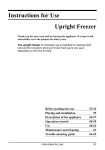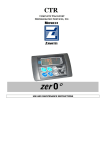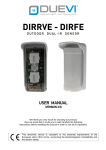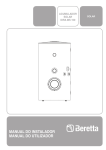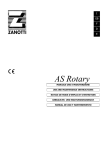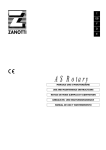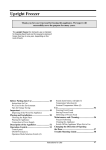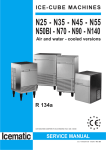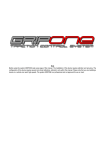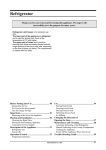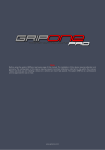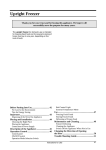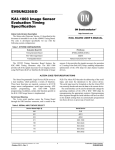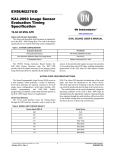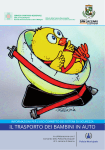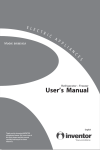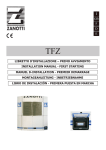Download UNOº User Manual - Complete Transport Refrigeration
Transcript
UN0° USE AND MAINTENANCE INSTRUCTIONS CONTENTS 1. Safety recommendations 2. Table of warning and attention plates 3. Description of the machine 4. Description of the controller 4.1. Starting the controller 4.1.1. Standard 4.1.2. Multi-temperature version 4.2. Setting diesel operation 4.3. Setting the work set point 4.3.1. Standard 4.3.2. Multi-temperature version 4.4. Enabling and disabling evaporators (only Multi-temperature version) 4.5. Starting the refrigerating unit 4.6. Manual defrost 4.7. Alarms 4.8. Alarm list 4.9. Description of alarms 4.10. Diesel operation lock (engine lock) 4.11. Service 4.12. Maintenance 4.12.1. Maintenance A 4.12.2. Maintenance B 4.12.3. Maintenance C 4.12.4. Maintenance D 4.12.5. Further maintenance instructions 5. Storage and stacking 6. Mobile partitions 7. How to use the refrigerating unit in the best way 8. Safe use 8.1. Engine coolant 8.2. Refrigerant 8.3. Battery 9. Troubleshooting 10. How to order spare parts 11. Warranty 12. How to dispose of the packing 13. How to dispose of the unit 2 Thank you for choosing Transblock. Please read these instructions carefully. They provide details and advice on the correct method of installing, using and maintaining this unit, in order to obtain maximum reliability, efficiency and long life 1. Safety reccomandations When installing and using the unit please follow the recommendations listed here below. • • • • • The machine should be installed according to the diagrams and instructions given by the manufacturer. Any damage due to improper connections is excluded. The neutral conductor, even if grounded, is not accepted as a safety conductor. The electric installation of the place where the unit is installed must comply with the regulations in force applicable to electrical installations. Maintenance shall be effected by trained personnel or by the manufacturer according to the provisions supplied by EN378. ATTENTI ON Use safety gloves to protect your hands from possible cuts. The user is strongly recommended to contact the manufacturer before attempting any intervention on the unit and any use not corresponding to the manufacturer’s indications (in particular as for the field of application) and to enquire about the possible dangers and contra-indications connected with an improper use of the machine. • The unit shall be used following these instructions and sticking to the destination of use indicated by the supplier. Any incorrect use can result in damage to the unit and represents a serious danger for people’s health. ATTENTION The unit is not suitable for working in explosive environments. Therefore the use of the unit in an explosion-dangerous atmosphere is absolutely forbidden. ATTENTI ON The unit is not suitable for w orking in salty environm ents. I n such a case protect condenser and evaporator w ith appropriate m eans. When maintenance involves operations on the cooling circuit, drain the system and let it reach the atmospheric pressure. W ARN I NG Do not discharge the refrigerant in the atm osphere. I t m ust be recovered by specialised technicians using a suitable equipm ent. • • • • Quantity and quality of the refrigerant to be charged are indicated on the data plate. Do not use refrigerants of different kind (especially inflammable refrigerants, for example hydrocarbons) or air. No modifications or changes in the refrigerating circuit or in components (such as: welding on compressor body) are allowed. The final user shall protect the unit from external fire dangers. 3 The unit has been so built as to maintain a constant temperature in the cold room during transport. This requires the load compartment to be equipped with a closing system ensuring perfect tightness, so that on unloading the product has a correct temperature; in addition when loading and arranging the product in the cold room make sure that it is perfectly ventilated. • Should a product be loaded at an excessive temperature, the unit will not be able to cool it, as this operation does not fall within the use it is intended for. The following recommendations are supplied for a safe use of the refrigerating unit: • • ATTENTI ON • • • • • • • Do not use any water or steam jets for cleaning purposes: they could damage the electric components of the unit. Keep the radiating masses of condenser and evaporator clean and free from obstructions. When the unit is connected to the mains, and in particular when it is in a closed environment, check that the condenser is not obstructed or too near the walls; in addition make sure that air circulation is adequate. Check that all securing screws are properly tightened and suitable for the intended use. When boring the unit or the vehicle frame, pay attention not to bore any refrigerating pipe, electric wire or any other component. Never close the compressor relief valves when the unit is operating. In case of operations on the unit, only use pressure gauges in good conditions. Do not put them in contact with any belts, with the pulley or the fan. W ARN I NG Carry out cleaning and maintenance operations only when the unit is still. After a certain period of operation the condenser and the high-pressure delivery pipes are particularly hot; wait for the unit to cool before any operation on it. • The unit includes moving parts such as fans, belts and pulleys. Pay special attention to them: work on the unit only when it is still and prevent accidental starting. • When working in the battery area (condenser and evaporator), be careful not to be cut by fin edges. • When the unit is operating, keep your hands far from fans and pulleys. • Handle the refrigerant taking all necessary safety measures. • When the refrigerant is placed near a source of heat it produces a gas with an unpleasant smell, which irritates the respiratory system. • Never use fire to heat a refrigerating circuit containing refrigerant. • Be careful when servicing the refrigerating circuit. On contact with the air, the refrigerant evaporates and immediately frostbites whatever is in close contact with it. • First-aid measures in case of frostbite: a) Cover the affected area. b) Quickly heat the frostbitten area by plunging it into cold water. c) If there is no water available, wrap up the affected area carefully with a clean cloth. d) If the refrigerant comes into contact with the eyes, rinse them immediately with clean water and call a doctor. e) Call a doctor. • Cooling oil Synthetic types Avoid long and repeated contact with the skin. After handling wash your hands thoroughly. The unit starts automatically; keep far from moving parts (belts, pulleys, fans). • • 4 2. Table of warning and attention plates ZANOTTI S.p.A. Via Martin L. King nr.30 46020 PEGOGNAGA (Mantova) - Italy 0496 1) Year of manufacture 2) Zanotti unit code 3) Serial number 4) Voltage 5) Ride absorption 6) Max. absorption 7) Starting absorption 8) Rated power of compressor 9) Refrigerant: Type, Quantity 10) Unit mass 11) Wiring diagram number 2005 Modello Model Matricola Serial number Tensione Voltage Assorb. Marcia Run Absorption A Assorb. Max Max Absorption A Potenza Compress. Compressor Power Kw Ass. Pspunto Start Abs. A Kw Refrigerante Refrigerant Kg Massa C Mass C Kg Massa E Mass E bar PSLP 20 bar °C TSLP -35 °C Kg Schemi Diag. PSHP 30 TSHP 100 PSV 30 bar Refrigerant Condensate drain line Attention: hot or cold parts Attention: danger of electrocution. Cut out the unit before opening the electric panel. Direction of rotation Colours of supply cable w ires Attention: sw itch off before servicing the unit Attention: rotating fans Diesel fuel delivery pipe Diesel fuel return pipe 5 3. Description of the machine The UN0° refrigeration units are made up of the following main components: 1. a condensing unit installed outside the isothermal box; 2. an evaporating unit installed inside the isothermal box; 3. an electronic central control unit located in the driver's cab of the vehicle. All models are suitable to store products both at positive and negative temperatures. 4. Description of the controller ZANOTTI UN0° refrigerating units are equipped with a microprocessor-based electronic controller (cabin control) which manages operation in a fully automatic way. In particular the electronic controller supervises the operations for starting and stopping the diesel engine and the electric motor depending on the set temperature. The operating mode (diesel or electric) is selected automatically by connecting the plug to the mains 4.1. Starting the controller Keep the first button on the right (ON/OFF) pressed until the display in on. Follow the same procedure to turn off the unit. After the introductory view, the state of the unit will be displayed. 4.1.1. Standard Press to start or stop the refrigerating unit; the display is left on. Electric operation Diesel operation n° 2 Evaporators n° 3 Evaporators 6 4.1.2. Multi-temperature version Electric operation n° 2 Evaporators n° 3 Evaporators Diesel operation n° 2 Evaporators n° 3 Evaporators 4.2. Setting diesel operation Press • point); to select the operating mode: automatic (start/stop): the unit starts and stops according to the set temperature (set continuous: temperature is kept steady without stopping the engine. • Press to select high or low speed (only for start/stop operating mode). ATTENTION Diesel operation is replaced with electric operation every time the unit is connected to the mains and switched on. In case of voltage drop during electric operation, diesel operation is resumed after about 5 minutes. 4.3. Setting the work set point Press and the following screen will appear: 4.3.1. Standard Press to decrease or increase value. 7 4.3.2. Multi-temperature version n° 2 Evaporators n° 3 Evaporators Press to reach the different set points (SP..) Press to decrease or increase value. To reach the main view press . 4.4. Enabling and disabling evaporators (only Versione Multi-temperature version) To enable or disable an evaporator press and the following screen will appear Then press to obtain the evaporator enabling/disabling screen. n° 2 Evaporators n° 3 Evaporators + Use state. to select the evaporator you are going to enable/disable and press To go back to the main view press to change its . 8 The main view will show the note n° 2 Evaporators indicating the disabled evaporator. n° 3 Evaporators 4.5. Starting the refrigerating unit Press to start or stop the refrigerating unit; the display is left on. 4.6. Manual defrost Keep pressed for 5 seconds in the main view. Defrost start is subject to defrost end thermostat (clixon) consent. During defrost icon appears and at the same time the button starts blinking. Defrost is followed by the dripping phase: the unit is still and the display blinks. 4.7. Alarms There are three 1) 2) 3) types of alarm: warning only, lock with automatic reset, lock with manual reset. Warning only: icon appears on the display, indicating that an alarm is on (see here below): The warning is accompanied with the activation of buzzers placed on the unit and on the controller. Press once to mute the buzzer on the controller. Press again to visualize the type of alarm in course. Icon indicates the alarm state: when it is displayed, the alarm is still active. 9 To mute the buzzer on the unit press . To clear the displayed warning and restore the default state, press again. To reach the main view press . When the alarm ceases automatically, the buzzers are muted but the warning on the display is left active. To clear the displayed warning and restore the default state go to the alarm screen and press . To go back to the main view press . Automatic reset alarm: the same as in “simple warning” occurs, with the only difference that the unit stops and starts again automatically when the alarm ceases. Manual reset alarm: icon and writing Locked appear. Buzzers are activated. • Press • When the cause for the alarm is removed, press state icon • Press twice to have alarm type displayed. and “no alarm” will appear. In the locked is left on even when the alarm has ceased. to go back to the main view. 10 • When the alarm has ceased, press to start the unit. 4.8. Alarm list Code Description A01 Room sensor failure alarm A04 Pressure switch alarm (min) A05 Oil level alarm A06 Air filter alarm A07 Water temperature alarm A08 Open door microswitch alarm A09 Open door alarm A10 Oil pressure alarm A11 Pressure switch alarm A12 Max. temperature alarm A13 Min. temperature alarm A14 Thermal relay alarm A15 Low battery alarm A16 Failed starting A17 Alternator failure alarm A18 Water sensor failure alarm Type Manual reset Automatic reset Warning only Warning only Manual reset Automatic reset Automatic reset Manual reset Automatic reset Warning only Warning only Automatic reset Manual reset Manual reset Manual reset Warning only 4.9. Description of alarms A01 Room sensor failure alarm This alarm causes the unit to stop permanently until the sensor has been repaired. To start the unit again . reset the alarm following the instructions supplied above and press the on/off button A04/11 Pressure switch alarm This alarm occurs when either the high or low pressure switch trips due to poor cleaning of the condenser or loosened condenser fan belts. The low pressure switch may also trip due to refrigerant leaks. The alarm interrupts the operation of the unit until the cause is removed. A05 Oil Level alarm It is a warning alarm which has no consequences on unit operation. A06 Air filter alarm It is a warning alarm which has no consequences on unit operation A07 Water temperature alarm This alarm occurs when the radiator water temperature exceeds the permitted value. It causes the diesel engine to stop until water temperature returns to normal values. 11 A08 Open door microswitch alarm This alarm occurs when the engine compartment door is opened. It prevents the engine from starting. A09 Open door alarm When there is the door microswitch, this alarm indicates that the load compartment door is open. A10 Oil pressure alarm This alarm occurs in case of engine oil pressure drop and it causes the diesel engine to stop permanently. To . restart the unit reset the alarm as described in above paragraph and press the on/off button A12/13 Max/Min. temperature alarm This alarm occurs when the difference between the actual cold room temperature and the temperature set using the control exceeds a factory-set limit. A14 Thermal relay alarm This alarm occurs in case of abnormal power absorption of the electric motor and it causes the unit to stop. To reset the alarm disconnect the unit, open the electric panel and reset the thermal relay by pressing the blue button. Close the electric panel and connect the unit to the mains. Then press the on/off button on the controller. A15 Low battery alarm This alarm occurs when battery voltage is lower than 11,5V. It causes the unit to stop until voltage is higher than 11,5V for at least 1’. A16/17 Failed starting or alternator failure alarm This alarm occurs when all starting attempts with the diesel engine (5, factory-set) have failed. Possible causes include: broken alternator, slacked belts, no fuel [flooded engine]. If the same alarm occurs during electric operation, it can be caused by alternator failure. To start the unit again reset the alarm following the . instructions supplied above and press the on/off button A18 Water sensor failure alarm It is a warning alarm which has no consequences on unit operation 4.10. Diesel operation lock (engine lock) To lock diesel engine operation keep pressed for some seconds, until icon the display indicating that diesel engine operation is impossible. Press 4.11. • Press • Press appears on to go back to the main view. Service to reach the mask that includes the maintenance button o o o o o . to have the following information displayed: Alternator voltage Battery voltage Water temperature Diesel engine hours Electric motor hours 12 4.12. Maintenance When a maintenance operation is necessary, icon appears in the main view. to reach the mask that includes the maintenance button . • Press • Press to have the code of the maintenance operation required displayed (see relevant paragraph in this manual). 4.12.1. Maintenance A • Replace diesel engine oil (1). • Replace oil filter. • Check air filter: clean it if necessary. • Check engine cooling system (2). • Check tightening of bolts securing the unit. • Check belt state and tension (3). • Check if condenser is clean. • Check controller operation. • Replace diesel oil filter. TIME NECESSARY FOR ABOVE OPERATIONS: 2 HOURS 13 4.12.2. Maintenance B • Check diesel fuel pump filter. • Replace air filter cartridge. • Check oil level in compressor. • Check alternator brushes. • Check battery terminals. • Check and adjust valve rockers. • Check refrigerant level. • Check operation of diesel engine thermostat. • Check defrost cycle. • Check brushes and operation of evaporator fans. • Replace belts, if necessary (3). • Check controller operation. TIME NECESSARY FOR ABOVE OPERATIONS: 3 HOURS 4.12.3. Maintenance C • Clean radiator and condenser (2). • Check refrigerant level. • Check diesel engine RPM (see technical data). • Check tightener pulley. • Check alternator charge. • Check evaporator fan brushes. • Check controller operation. TIME NECESSARY FOR ABOVE OPERATIONS: 3 HOURS 4.12.4. Maintenance D • Check all tighteners (3). • Replace antifreeze in diesel engine (2). • Check electric motor bearings. TIME NECESSARY FOR ABOVE OPERATIONS: 3 HOURS 4.12.5. Further maintenance instructions Before any maintenance operation make sure that the controller is OFF and the refrigerating unit can not start. In addition to the above-listed operations, we strongly recommend to follow these further instructions: (1) Replace engine oil at least one a year, even if the engine has not reached the prescribed operating hours. Recommended oils: ZANOTTI 10W – 40 ELF Multiperformance 4D – 10W - 40 AGIP SIGMA TURBOSHPD 10W – 40 MOBIL DELVAC SHC 10W – 40 DELVAC 1400 SUPER FIAT URANIA TURBO 10W 40 SHELL MYRINA TX 10W 40 BP VANELLUS C3 EXTRA 10W 40 14 (2) The coolant (protection down to –36°C Long Life “B”) must be replaced at least every 2 years. (3) BELTS A correct belt tension enables better transmission and reduces belt wear. Attention: when two belts are mounted together and one of them needs replacement, replace BOTH belts. Storage and stacking 5. One of the main concerns when storing goods is how to ensure proper air circulation in the isothermal cold room. If air cannot circulate freely throughout the cargo, ice or warm areas will almost certainly develop which could irreparably damage the goods. The first action to be taken is to store the goods on pallets. If loaded in a proper way, goods on pallets let air circulate freely in and out of the evaporator. Furthermore, they will be protected by the pallet from the heat passing through the floor of the trailer. Proper air circulation is extremely important too when stacking the goods. In fact some goods tend to produce heat, while others don't. Fruit and vegetables, for example, belong to the first group. In this case the goods should be stacked in such a way as to ensure good air circulation through the cargo. On the contrary, items which do not generate any heat (such as meat, deep frozen products and fresh packaged products) should be stacked in the middle of the cold room. Do not lean the goods against the cold room walls: as they filter heat from the environment they would cause damage to the goods. ZANOTTI UN0° refrigerating units are designed to keep the goods at their loading temperature; they are not suitable to refrigerate warm products Mobile partitions 6. There are different minimum clearances at which mobile partitions should be placed, depending on the UN0° ZANOTTI refrigeration unit model. Such clearances are: • UN0° 080: 1400 mm / about 4' 7 1/2" • UN0° 100: 1800 mm / about 6' • UN0° 120: 2700 mm / about 9' The air pipes of the evaporator should always be left undisturbed. How to use the refrigerating unit in the best way 7. • Open the doors as briefly as possible. • Before selecting the required cold room temperature, check the temperature of the goods to be carried. • Keep a minimum distance of 10/15 cm. between cargo and cold room walls. 15 • Park your vehicle in the shade and make sure that the ZANOTTI UN0° refrigeration unit does not remain idle for a long time. 8. Safe use ZANOTTI UN0° units are built to ensure the operator’s total safety. Nevertheless, for any operation carried out inside the unit (checks, repair or maintenance work) the operator should wear safety gloves to prevent burns due to the accidental contact with hot components and cuts due to contact with condenser or evaporator fins. 8.1. Egine coolant ZANOTTI UN0° units, like all engines, operate with a coolant which, under normal operation conditions, is subject to high pressures and temperatures in the engine and radiator. For this reason a spill or release of coolant can cause severe scalds. Never remove the cap from a hot radiator. Should this be absolutely necessary, unscrew it very carefully so that pressure can stabilise slowly and evenly. 8.2. Refrigerant The refrigerant contained in the refrigeration system can cause serious injuries if it comes into contact with any part of the body, and burns, frostbite and even blindness if it comes into direct contact with the eyes. For this reason the regulations applicable to the handling of refrigerants during maintenance operations provide for the customer to call the nearest service centre to have the unit serviced or repaired. 8.3. Battery It is strictly forbidden to smoke while checking the unit. Batteries, in fact, release small amounts of hydrogen which can ignite and cause the battery to explode and the operator to be seriously injured or blinded. 9. Troubleshooting Zanotti UN0° units are tested and certified for correct operation. Nevertheless, should a problem occur, check the following table before contacting a Service Centre. Trouble On turning on, the engine does not start The unit won't start The unit jams The unit does not cool properly Checks to carry out Check flat battery. Check battery connections. Check fuses. Check fuel level. Check engine oil level. Check fuses. Check belts tension. Check engine oil level. Check coolant level. Check fuel level. Check fuses. Defrost the unit. Check something hinders the proper ventilation of the evaporator. Check Something hinders the proper ventilation of the condenser. Check The isothermal cold room might be damaged or have leaks. 16 10. How to order spare parts When ordering spare parts make reference to the serial number written on the unit plate. W ARN I NG W orn parts should be replaced only by qualified personnel or by the m anufacturer. 11. Warranty Keep your warranty certificate carefully; you will be required to show it whenever your refrigeration unit needs servicing. The machine should be installed according to the diagrams and instructions given by the manufacturer. Any damage due to improper connections is excluded from the warranty. The neutral conductor, even if grounded, is unacceptable as a safety conductor. The electrical installation of the place where the unit is installed must comply with the regulations in force applicable to electrical installations. The machine must be used according to the user's instructions and only for the use the manufacturer intended it for. 12. How to dispose of the packing Wooden, plastic, polystyrene packing shall be disposed of according to the regulations in force in the country where the unit is used. 13. How to dispose of the unit Do not discharge scrapped components in the environment. They should be disposed of by companies dealing with special waste collection and recovery, according to the regulations in force in the country where the unit is used. W ARN I NG Do not discharge the refrigerant in the atm osphere. I t should be disposed of by com panies dealing w ith special w aste collection and recovery. 17 18



















